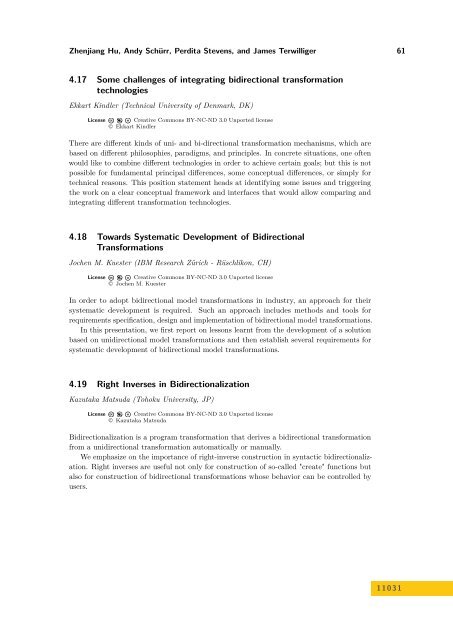Volume 1, Issue 1, January 2011 - DROPS - Schloss Dagstuhl
Volume 1, Issue 1, January 2011 - DROPS - Schloss Dagstuhl
Volume 1, Issue 1, January 2011 - DROPS - Schloss Dagstuhl
You also want an ePaper? Increase the reach of your titles
YUMPU automatically turns print PDFs into web optimized ePapers that Google loves.
Zhenjiang Hu, Andy Schürr, Perdita Stevens, and James Terwilliger 61<br />
4.17 Some challenges of integrating bidirectional transformation<br />
technologies<br />
Ekkart Kindler (Technical University of Denmark, DK)<br />
License Creative Commons BY-NC-ND 3.0 Unported license<br />
© Ekkart Kindler<br />
There are different kinds of uni- and bi-directional transformation mechanisms, which are<br />
based on different philosophies, paradigms, and principles. In concrete situations, one often<br />
would like to combine different technologies in order to achieve certain goals; but this is not<br />
possible for fundamental principal differences, some conceptual differences, or simply for<br />
technical reasons. This position statement heads at identifying some issues and triggering<br />
the work on a clear conceptual framework and interfaces that would allow comparing and<br />
integrating different transformation technologies.<br />
4.18 Towards Systematic Development of Bidirectional<br />
Transformations<br />
Jochen M. Kuester (IBM Research Zürich - Rüschlikon, CH)<br />
License Creative Commons BY-NC-ND 3.0 Unported license<br />
© Jochen M. Kuester<br />
In order to adopt bidirectional model transformations in industry, an approach for their<br />
systematic development is required. Such an approach includes methods and tools for<br />
requirements specification, design and implementation of bidirectional model transformations.<br />
In this presentation, we first report on lessons learnt from the development of a solution<br />
based on unidirectional model transformations and then establish several requirements for<br />
systematic development of bidirectional model transformations.<br />
4.19 Right Inverses in Bidirectionalization<br />
Kazutaka Matsuda (Tohoku University, JP)<br />
License Creative Commons BY-NC-ND 3.0 Unported license<br />
© Kazutaka Matsuda<br />
Bidirectionalization is a program transformation that derives a bidirectional transformation<br />
from a unidirectional transformation automatically or manually.<br />
We emphasize on the importance of right-inverse construction in syntactic bidirectionalization.<br />
Right inverses are useful not only for construction of so-called "create" functions but<br />
also for construction of bidirectional transformations whose behavior can be controlled by<br />
users.<br />
1 1 0 3 1













